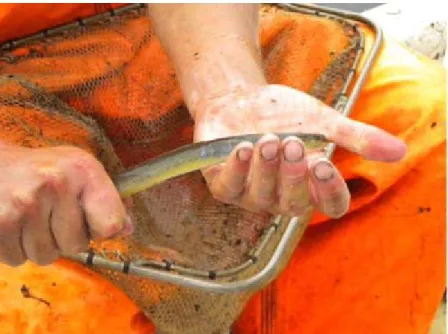Home > News and Agenda > IVM Newsletter > Latest issue > Chemistry and Biology
Perspectives for handling fishery products from contaminated areas
Concentrations of dioxins and PCB’s in eel (Anguilla anguilla) from the Rhine-Meuse estuary have dropped markedly since the 1970s and 1980s. However, current levels in the Dutch part of these rivers are still above European consumption standards and restrictions have been imposed. In the current study various options were explored to derive products that are safe for consumption.
Fig. 1 Eel - Courtesy: Ap de Wit
During the 1980’s the fishery and consumption of eel was restricted for this reason and since 2011 the fishery and trade of eel and Chinese mitten crab (Eriocheir sinensis) has been forbidden in most sections of the large rivers and connected waterways in the Netherlands. E. sinensis is an invasive species with high densities in the estuarine areas and the fisheries during the autumn months have increased during the last decade. IVM was approached by an organization of local fishermen to investigate the perspectives for future fishery activities in this area and to deliver products with contamination levels below human consumption standards, i.e. white meat from the crabs and translocation and further growth of juvenile eel (28-32 cm) to cleaner habitats. For the eel, lower contamination levels may also contribute to the recovery of the species in the Netherlands.
Chemistry and Biology - Latest issue - VU University, Institute for Env... http://www.ivm.vu.nl/en/news-and-agenda/IVM-Newsletter/latest-issu...
Fig. 2 Chinese mitten crab - Courtesy: Bert van Hattum
The present study was focused on temporal variation in dioxin and PCB concentrations in different size classes of eel and Chinese mitten crabs at ten locations in the restricted area. Juvenile eel (28-32 cm) from an exposed location were marked and translocated to a clean site (Berkenwoude) and the effect on the dioxin and PCB concentrations were followed. For both eel and Chinese mitten crabs a considerable variation was observed between locations, with in general relatively lower concentrations at the more coastal (Maasvlakte, Haringvliet). High concentrations were found in the hepatopancreas (or brown meat) of the Chinese mitten crabs; concentrations in the white muscle meat of legs, claws and body were low and well below the European consumption standards at all locations. In eel, concentrations increased markedly with size classes; for the small eel (28-32 cm) concentrations were below or around the consumption standard. In the translocation experiment, a marked decrease (up to almost 50%) was noted after 1 year and attributed to probable metabolism of congeners with a specific chlorination pattern and other non-explained elimination
pathways. Concentrations were well below consumption standards. Simple growth dilution models predicted further decreases in adult eel (>600 g). The results confirmed the outcome of previous elimination experiments with contaminated eel. The outcome of the study has led to new initiatives and material for discussion among stakeholders about the perspective of sustainable management and fisheries on eel and Chinese mitten crabs in the Netherlands.
Authors: Bert van Hattum1, Philip Nijssen1, Jeff Focant2 and Jacob de Boer1 1
Institute for Environmental Studies, VU University, Amsterdam, The Netherlands 2
Organic and Biological Analytical Chemistry – CART, University of Liège, Belgium
Articles:
Dioxines en PCB’s in paling uit het Benedenrivierengebied. Veldonderzoek 2012 en resultaten uitzetexperiment met pootaal.
Dioxines en PCB’s in Chinese wolhandkrab uit het Benedenrivierengebied.
Corresponding and presenting author:Bert.van.hattum@ivm.vu.nl
© Copyright VU University Amsterdam
This site uses cookies. By visiting this site you are consenting to the use of cookies on this site. I accept cookies More information
Chemistry and Biology - Latest issue - VU University, Institute for Env... http://www.ivm.vu.nl/en/news-and-agenda/IVM-Newsletter/latest-issu...

